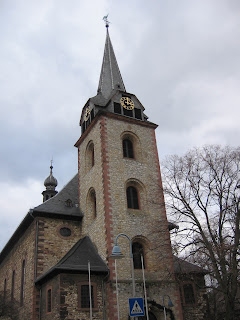Phillip Huber, my great-great-grandfather, was born on December 17, 1847 in the town of Flörsheim to Georg Huber (1809-1900) and Eva Katherina Fauth (1807-1875). About 1868 he arrived in America, just 21 years old, and settled in Woodburn, Warren County, Kentucky. On April 25, 1871, he married Barbara Brunett (1852-1896), born in Jennings County, Indiana. They settled in Bowling Green, Warren County, Kentucky and had six children, John William "Willie" (born February 8, 1872), Mary Bertha "Mayme" (born August 8, 1873), Ida Catherine (born February 28, 1875), Philomena Barbara "Minnie" (born September 20, 1876), Clarence Joseph (born January 17, 1879), Magdelena "Lena" (born April 18, 1881) and Charles Thomas (born March 11, 1883). After the death of his wife and three of their children, Phillip moved his family to Birmingham, Alabama, where he died on April 4, 1901. Their daughter Mayme, my great-grandmother, married John Martin O'Donnell on February 11, 1904, in Birmingham. Their oldest child, John Huber O'Donnell (1905-1964) is my grandfather.
 |
| Flörsheim am Main, Hesse, Germany |
Flörsheim, also known as Flörsheim/Main, is located in the Main-Taunus-Kreis district of Hesse, Germany. The city is situated on the right side of the Main River. The following information was taken from the german website:
http://www.kulturland-rheingau.de.
 |
| Coat of Arms |
"Flörsheim/Main was first mentioned in documents dating back to 828, however, the municipal laws and the additional name “am Main“ were only bestowed upon the town in 1953. In 1972 Flörsheim, Weilbach and Wicker formed the town of Flörsheim/Main.
The historic centre of Flörsheim – with the spa park Bad Weilbach and the remains of the Linear Pottery settlement were included in the UNESCO list of protected cultural goods in 2008 – was surrounded from the middle of the 16th century onwards by a drystone wall whose preserved remnant is the Main Tower.
 |
St. Gall's Church
St. Gallusgemeinde |
The impressive outline of St. Gall's Church as a typical example of the rural late baroque art of church construction, characterises the town. The famous Gall’s Concerts (“Gallus Konzerte”) have been taken place in the baroque chancel for more than 25 years. In the historic centre and communal district of Flörsheim numerous wayside crosses and chapels from the 17th to the 19th centuries can be found, which are partly stations during the great procession called “Prozessionsweg am Verlobten Tag“. This day has been celebrated for more than three hundred years annually on the last Monday of August in remembrance of the fact that the town had overcome the plague epidemic of 1666.
With the signature “FFF“ the Faience Factory of Flörsheim is still present in the town’s coat of arms. The prince-elector from Mainz established the manufactory in Flörsheim in 1765. Numerous jugs, vases and objects manufactured in the faience factory are on display in the Museum of local history, as well as a considerable number of paintings by Christian Georg Schütz Sen. born in Flörsheim in 1718 and his entourage.
 |
| Flörsheim Watchtower |
The
Flörsheim Watchtower (“
Flörsheimer Warte”), once erected as a watchtower of the territorial army of Kastel, is not only the distinctive landmark on the Wicker high ground (“
Wickerer Anhöhe”). While drinking a nice glass of wine visitors can enjoy a spectacular view over the vineyard site "
Herrnberg" down into the Main valley and across the Forest of Odes. The second vineyard site in Flörsheim, "
St.-Anna-Kapelle" is located in the area of the Wiesenmühle. St Anne’s Chapel built in 1715 is located there, which is dedicated to St Anna Selbdritt who gave the vineyard site its name. Flörsheim has its own wine tasting stand since August 2010. The wine growers from Flörsheim and Wicker offer their wines from the end of April to the beginning of October, from Fridays to Sundays in a pavilion on the Main dam and guarantee visitors and guests an enjoyable and good time.
The town’s offer as for culture, free time and relaxation is written in large capitals, additionally festivals and markets characterise the lively town of Flörsheim/Main in the course of the year. Numerous hikers and pilgrims pass through Flörsheim-Weilbach on their hike along Bonifatiusroute from Mainz to Fulda. Visitors can take the Main Bicycle Route (“Main-Radweg”) R3, one of Germany’s most famous long-distance cycling trails on Flörsheim’s side of the Main.
 |
| Flörsheim - on the River Main |
Under the motto “Give the Landscape Meaning – a Landscape for the Senses“ the regional Park Rhine-Main aims at protecting open spaces between the settlements in the conurbation of Rhein Main and at developing them as habitat and people’s place for relaxation. Numerous ways and itineraries, squares and observation points designed by horticulture and architecture as well as artistically designed objects and installations offer famlies with children attractive destinations in Flörsheim and its vicinity: the “Poet’s House” (“Haus des Dichters“) in Weilbach as well as the “stones along the panoramic path”, (“Steine am Panoramaweg“), the former territorial army of Kastel (“Kasteler Landwehr“), the Flörsheim Watchtower or the iron tree in ”Flörsheimer Schweiz“."
 |
| Map of Flörsheim (inset Germany) |
The
Mainstein is a sculpture in Flörsheim depicting some of the history of the town. The lower part depicts the Mainz Cathedral, the 1000 year old center of the Archbishopric of Mainz, the former principality of the Holy Roman Empire of which Flörsheim, Wicker and Weilbach were ruled. The geese in the center section depict the geese-breeding industry in the town; the wheat carving represents the history of cultivation of grain in the area.
 |
"Der Mainstein"
Collage from Mainzauber.de/blog |











You did a great job with your site. I enjoyed the information on Florsheim, my family emmigrated from here in 1825 and went to Illinois.
ReplyDelete